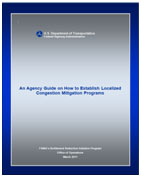|
|
An Agency Guide on Overcoming Unique Challenges to Localized Congestion Reduction Projects4.0 Guidelines for Successful Localized Bottleneck Reduction Projects4.1 Overview of GuidanceThis document, An Agency Guide on Overcoming Unique Challenges to Localized Congestion Reduction Projects, provides guidance developed from successful localized bottleneck reduction programs and projects. As has been demonstrated throughout this document, there is a wide variety of barriers and challenges to successful project implementation, and many agencies have taken unique approaches to overcome them. There is no one size fits all or cookie-cutter way of attacking localized congestion with low-cost bottleneck improvements. However, the following guidance is synthesized from practical experience from over 50 successful bottleneck removal projects and feedback from transportation professionals throughout the country. 4.2 Guidance For Successful Localized Bottleneck Reduction ProjectsThis section presents ten high-level guidelines to assist agencies in the development and execution of successful localized bottleneck reduction projects. Each of the ten guidelines is presented in a text box and then followed by a short explanation of how this guidance can be applied. 
Guideline 1: Get a high-level project champion to promote the project and/or program.Having a project champion, ideally a high-level person with decision-making authority and respect from peers is desirable for getting low-cost localized congestion projects implemented. The tenth case study in Texas highlights the importance of this principle with champions from both the Texas DOT Dallas District Engineer (highest level DOT local authority) and the Director of Transportation for the North Central Texas Council of Governments, the Dallas/Fort Worth MPO. 
Guideline 2: Find the exact problem and place the improvement to help this movement.It is critical to successful bottleneck removal to find the exact problem causing the congestion and place the right improvement to help serve that underserved movement. Resurrecting Transportation System Management (TSM) thinking is the key to use of this strategy of obtaining short-term congestion relief without unnecessarily impacting other movements or just moving the bottleneck to a nearby downstream location. Guideline 3: Collect enough of the right data in order to perform the proper analysis.Another important component is to collect enough of the right data to capture the extent of queuing, both in time and space, so that a proper analysis of improvement alternatives can be performed. Having the right data — before and after — will be necessary for an appropriate performance evaluation to capture the real-world benefits after the project has been implemented. At times, the collection of speed data on parallel routes is important, since traffic diversion may occur after the improvement. 

Guideline 4: Establish low-cost bottleneck removal in a formal project development process.It is important to realize that there is significant value in making low-cost bottleneck removal part of an established project development and/or planning process and involving multiple agencies in implementation. Examples of this type of approach and coordination were evident in the case studies presented in Section 3 and a companion guidance document, An Agency Guide on How to Establish Localized Congestion Mitigation Programs, which provides three templates that can be used to start new programs. Having a named program can also help gain visibility and support and lead to more frequent opportunities for successful project implementation. 
Guideline 5: Use a team-based approach.Like many types of projects, implementation of localized congestion removal projects benefits from the use of a team-based, collaborative approach. Case studies of successful programs and projects have shown that many agencies emphasize interagency coordination (sometimes through formal processes such as traffic management teams, design charrettes, major investment studies, etc.) because of the positive synergy and opportunities for collective brainstorming. One project champion that was interviewed during this project indicated that “bottlenecks are a team sport”. Guideline 6: When possible test trial a bottleneck improvement prior to the permanent fix.Several case studies have demonstrated that it is a great advantage to be able to test a bottleneck improvement prior to the permanent fix. This allows an agency, and possibly even the public, to overcome fears about potential negative outcomes. The best case is being able to physically test the bottleneck improvement at the real-world site. Examples of real-world trials include the Florida DOT using the cones for a temporary merge pattern prior to restriping (see Figure 3) and the Texas DOT using barrels to temporarily close ramps prior to their permanent closure. When a real-world trial is not feasible, the use of microsimulation models can serve the same purpose and also provide reassurance to both internal and external audiences about the likelihood of success of the proposed improvement. 
Guideline 7: Utilize a consistent approach to project analysis and development.Another key component to successful project delivery is to utilize a consistent approach to project analysis and development. The Texas Transportation Institute (TTI) has developed the four-step process, IDEA, based on analysis of dozens of freeway bottleneck projects. The IDEA process consists of the following four steps:
There is no standard approach to project analysis and development, and other agencies have developed similar frameworks to TTI that are useful for this purpose. 
Guideline 8: Utilize lessons from other successful projects to overcome common barriers.This document is intended to provide individual transportation professionals and the agencies they serve the information needed to overcome common barriers and challenges to implementing low-cost localized congestion relief projects. The lessons learned and unique approaches highlighted in Section 3 should give individuals and agencies confidence that relieving congestion with low-cost improvements is possible and often results in significant operational and safety benefits being realized for relatively little cost. 
Guideline 9: Agencies should not delay implementation of improvements because most projects pay for themselves in one year.Several case studies, particularly for the 20 projects in Texas, reveal that the benefits of low-cost bottleneck projects typically have benefit-to-cost ratios ranging from 3:1 to 400:1, based on service lives estimated from 5 to 20 years. Further economic analysis reveals that many of these projects actually pay for themselves (i.e., have B/C ratios greater than 1.0) after only one year. This reality supports the guidance that agencies should not delay implementation of improvements because they are extremely cost-effective in an era of constrained funding. 
Guideline 10: Skipping the final step (assessment of outcome) takes away the opportunity for lessons learned and potential praise.Several agencies, notably the Minnesota and Texas DOTs, have done an excellent job of making sure to evaluate many of the low-cost localized congestion removal projects they have implemented. Skipping the assessment of outcome of the project leaves the benefits undocumented, removes the opportunity for lessons learned, and also takes away the prospect of potential praise from stakeholders and the media. Taking the time and dedicating the resources up front to make sure assessment of outcome is performed are likely to lead to more successful projects in the future. September 2011 |
|
United States Department of Transportation - Federal Highway Administration |
||